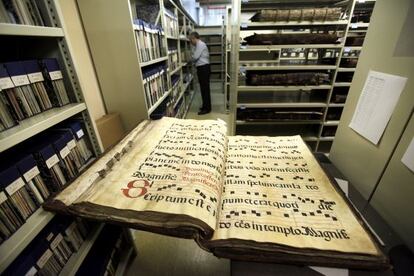Treasure trove of golden oldies
Spain's National Library has hundreds of years' worth of musical compositions in its archives The institution is celebrating its third century with a series of events and exhibitions

The National Library is celebrating its tercentenary this year with a series of events and exhibitions aimed at making the institution better known and encouraging the general public to make better use of its facilities, particularly its vast music and audiovisual collection.
With this in mind the Spanish National Orchestra gave a concert last Saturday at the National Auditorium in Madrid, playing a pot pourri of pieces from scores in the National Library's collection that range from Joaquín Rodrigo's original transcription for his eternally popular Concierto de Aranjuez, first performed in 1940, to madrigals written as illuminated manuscripts dating back to the 12th century.
"The National Library has the finest collection of Spanish music anywhere, and includes transcriptions of songs dating back 800 years that have never been recorded," says José Carlos Gosálvez, the head of the body's music and audiovisual department.
The National Library's collection of music originally came from that of the Royal Library, and was saved when the royal palace, the Alcázar, burnt down in 1734. It was added to the National Library when the institution's present home next to Madrid's Plaza de Colón was built in 1886.
Among the National Library's treasures are manuscripts of organ pieces by baroque composer Antonio Martín y Coll, as well as liturgical works commissioned by Cardinal Cisneros, the power behind the throne of Isabel and Ferdinand in 15th century Spain.
As well as housing a magnificent collection of medieval music scores that highlight the leading role Spain played in establishing many musical forms, such as polyphonic singing, the National Library also includes a huge collection of recorded music, beginning with piano rolls, cardboard records and wax cylinders, moving on to gramophone recordings and cassettes.
"There are hundreds of thousands of records and more than 100,000 cassettes. On our web site it is already possible to listen to 6,500 recordings made prior to 1956," says Gosálvez.
The National Library's audiovisual collection includes a copy of every film ever made in Spain, and like its collection of sound recordings it is gradually being transferred to digital.
"At the Biblioteca Nacional de España, the collection of audio-visuals was formed through the compulsory delivery of at least one copy of each videographic publication, in compliance with the Copyright Library act," says Gosálvez.
The current collection of audio-visuals at the National Library is made up of video tapes, DVDs, and Blu-ray. "Although modern, the collection is of great importance, as it preserves nearly the entire domestic production of audio-visuals over the past 30 years," says Gosálvez.
"One of the characteristics of audio-visual documents is the speed with which both media and players become obsolete due to the whirlwind transformation prompted by technical advances and commercial practices. To address this problem, a digitalization project to ensure the preservation of all video tapes has been established within the National Library's preventive preservation programme.
"We want the public to take an interest in our collection and to use it. We hope that the process of digitalization will also make our collection available to the rest of the world," he says.
"Most people see the National Library as a place solely for historians and researchers, which is closed to the general public, but that isn't true. Anybody can come here to see a film, to read a book, or to listen to music," says Beatriz Rodríguez Albert, the daughter of Joaquín Rodrigo.
"We have just about everything related to Spanish music in our archive: from Gregorian chant to the latest pop song, taking in jazz, groups from the movida Madrileña in the 1980s, or music from around the world," Rodríguez Albert adds.
Tu suscripción se está usando en otro dispositivo
¿Quieres añadir otro usuario a tu suscripción?
Si continúas leyendo en este dispositivo, no se podrá leer en el otro.
FlechaTu suscripción se está usando en otro dispositivo y solo puedes acceder a EL PAÍS desde un dispositivo a la vez.
Si quieres compartir tu cuenta, cambia tu suscripción a la modalidad Premium, así podrás añadir otro usuario. Cada uno accederá con su propia cuenta de email, lo que os permitirá personalizar vuestra experiencia en EL PAÍS.
¿Tienes una suscripción de empresa? Accede aquí para contratar más cuentas.
En el caso de no saber quién está usando tu cuenta, te recomendamos cambiar tu contraseña aquí.
Si decides continuar compartiendo tu cuenta, este mensaje se mostrará en tu dispositivo y en el de la otra persona que está usando tu cuenta de forma indefinida, afectando a tu experiencia de lectura. Puedes consultar aquí los términos y condiciones de la suscripción digital.
Últimas noticias
More than 40 Democratic lawmakers urge Trump in a letter to stop his ‘attempts to undermine democracy in Brazil’
The journal ‘Science’ criticizes Trump’s anti-renewable energy policy: ‘The US is failing to benefit from its own innovations’
Cubans hope for a miracle as dengue and chikungunya spread
The long shadow of the father figure in the films of Rob Reiner
Most viewed
- Christian Louboutin: ‘Young people don’t want to be like their parents. And if their parents wear sneakers, they’re going to look for something else’
- Cartels in Mexico take a leap forward with narco-drones: ‘It is criminal groups that are leading the innovation race’
- ‘El Limones’ and the growing union disguise of Mexican organized crime
- Liset Menéndez de la Prida, neuroscientist: ‘It’s not normal to constantly seek pleasure; it’s important to be bored, to be calm’
- The low-cost creative revolution: How technology is making art accessible to everyone








































